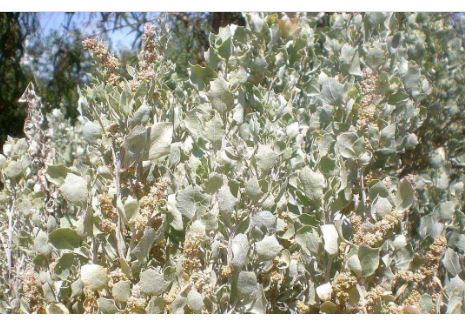
Saltbush belongs to the genus Atriplex, which is part of the family Amaranthaceae. Within this genus, there are numerous species, but some of the most commonly recognized are Atriplex canescens (fourwing saltbush), Atriplex confertifolia (shadscale saltbush), and Atriplex gardneri (Gardner’s saltbush). These plants are characterized by their adaptability to saline and arid conditions, making them notable for their environmental resilience.
The native range of saltbush species spans across various continents. In North America, saltbushes like Atriplex canescens are found from the Great Plains to the Great Basin and the desert Southwest, while Atriplex confertifolia is predominant in the Great Basin and Colorado Plateau. In Australia, species such as Atriplex cinerea (grey saltbush) are native to coastal areas and around salt lakes. Eurasia and South America also host native Atriplex species, showing the global distribution of this adaptable genus.
Saltbushes have been integral to many cultures. Indigenous peoples of North America used various species for food, medicine, and dye. For instance, Native American tribes utilized the seeds and leaves of fourwing saltbush for nutrition or as a tea. In Australia, saltbushes have been part of the landscape for millennia, used by Aboriginal Australians for food and shelter, particularly in arid regions where these plants thrive. The introduction of saltbushes to other continents, like Australia to the Americas for land reclamation, also marks their historical significance in agriculture and land management.
Saltbushes are typically shrubs or small trees with a woody base, growing from 1 to 6 feet tall. They are known for their grey-green, often small, scale-like leaves that help reduce water loss, suiting them to dry, saline environments. Many species are dioecious, with separate male and female plants. The fruits of saltbushes are unique, often having wings or bracts, which aid in wind dispersal. They’re halophytes, meaning they can grow in soils with high salt content, where other plants might struggle.
The hardiness of saltbush species varies, but many thrive in USDA Hardiness Zones 3 through 10, depending on the exact species. For example, Atriplex canescens can grow in zones 4 to 9, while Atriplex confertifolia is suited for zones 5 to 9. These zones reflect their adaptability to cold winters and hot, dry summers.
Saltbushes can be quite long-lived, with some species living for decades. For instance, Atriplex canescens can live for 50 to 100 years under favorable conditions, showcasing their resilience and ability to adapt to harsh environments. Their longevity is also supported by their ability to regenerate from roots or crown sprouts after disturbances like fire.
Landscape Uses
In landscaping, saltbushes are valued for their drought tolerance and ability to stabilize soils in arid or saline areas. They’re used for:
- Xeriscaping: Ideal for low-water gardens, providing structure and greenery without high maintenance.
- Erosion Control: Their extensive root systems help in soil stabilization, particularly on slopes or sandy soils.
- Wildlife Habitat: They serve as food and shelter for various species, including birds and small mammals, thus enhancing biodiversity.
- Reclamation: Planting saltbushes aids in rehabilitating degraded lands, particularly those affected by salinity or in desert reclamation projects.
- Ornamental Purposes: Some varieties with attractive foliage or growth habits are used in ornamental gardens, especially in regions where water conservation is paramount.
Saltbush: Cultivation
Choosing the Right Species
Select a species like Atriplex canescens for dry, inland conditions or Atriplex halimus for more coastal, saline environments, based on your local climate and soil.
Soil Conditions
Saltbushes thrive in well-draining, sandy, or loamy soils but are particularly suited to saline and alkaline soils. They can tolerate poor soil quality where other plants might fail.
Sunlight
These plants require full sun to flourish, so ensure the planting site gets at least 6 hours of direct sunlight daily.
Watering
Once established, saltbushes are drought-resistant. Water newly planted specimens regularly until they’re established, then reduce watering as they prefer dry conditions. Overwatering can be detrimental.
Planting Time
The best time to plant saltbush is in early spring or fall when temperatures are moderate. This helps the plant establish before facing extreme weather conditions.
Spacing
Space plants according to their mature size, generally 3 to 6 feet apart, to allow for good air circulation and growth without competition.
Propagation
Saltbushes can be propagated from seeds, cuttings, or by division. Seeds should be cold stratified if necessary, while cuttings from semi-hardwood can root in a mix of sand and peat under mist.
Pruning
Prune to shape or control size, especially in late winter or early spring before new growth. Remove dead or crossing branches to promote health and vigor.
Fertilization
Generally, fertilization is not necessary due to their ability to grow in nutrient-poor soils. However, if growth seems stunted, a low-nitrogen, slow-release fertilizer can be used sparingly.
Weed Control
Initial weed control is crucial until saltbush establishes itself. Use mulch or mechanical methods to suppress weeds, as chemical herbicides can harm young plants.
Pest and Disease Management
Saltbushes are relatively pest-resistant but can occasionally be affected by scale insects or aphids. Use insecticidal soap or neem oil if infestations occur. Fungal diseases are rare but can be managed with good air circulation.
Landscaping and Use
Use saltbush in xeriscaping, as windbreaks, for erosion control, or as part of a native or wildlife garden. They’re excellent for rehabilitating degraded or saline lands, providing both ecological and aesthetic benefits.